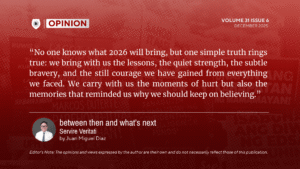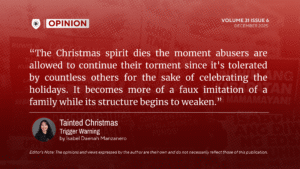By Alisandra Sophia M. Untalan | July 13, 2025
Benedictine Communities Honor the Feast of St. Benedict of Nursia
HONORING the life and legacy of St. Benedict, SBCA celebrated his Feast Day with a eucharistic celebration last July 11. Other institutions across the Philippines and around the world also marked the occasion in their unique ways.
The Feast Day reflects the enduring spiritual and educational influence of St. Benedict of Nursia, the founder of Western Monasticism and author of the Rule of St. Benedict.
One Rule, Two Feast days
St. Benedict of Nursia lived during the fifth and sixth centuries and established a monastic lifestyle, emphasizing prayer, work, humility, and community life centered around obedience and humility. After experiencing the corrupt life of Rome, he left to start a solitary life at Subiaco, where he later founded his monastic communities.
His legacy endures through 7,000 monks in 400 monasteries worldwide, underscoring his lasting impact, even beyond his death, traditionally believed to have occurred on March 21, 547.
St. Benedict is honored with two feast days in the liturgical calendar. March 21 is a tradition that continues to be celebrated annually by Benedictines. According to tradition, the relics of St. Benedict were transferred to the monastery of Fleury (France) in 672, giving rise to the second feast day, celebrated by the United States and SBCA on July 11.
Thus, the feast of St Benedict is now generally held on July 11, but Benedictine monasteries also maintain a celebration on March 21.
Ora et Labora: The Bedan Way
At SBCA, the celebration of the Feast of St. Benedict is more than a liturgical commemoration, it is a deep expression of the Bedan identity rooted in the Benedictine motto Ora et Labora (prayer and work).
The Bedan community, composed of its administrators, faculty and staff, gathered at the St. Benedict Chapel for the Eucharistic celebration on the Solemnity of St. Benedict. The Mass was presided by Rev. Fr. Rembert Tumbali, OSB, with Rev. Fr. Gerardo Ma. D. De Villa, OSB, as preacher.
As shared by Alexeis Emmanuel Gelverio, moderator of the Knights of the Altar, the commemoration often honors individuals who have dedicated years of service to the school. These include employees celebrating milestones of 10, 15, 20, or more years, as well as retirees and those who have contributed to Bedan Identity and way of life.
This year’s celebration highlights the call “to prefer above all the love of Christ,” reminding the Bedan community to remain steadfast in their commitment to Jesus. “We celebrate our Holy Father Benedict and our identity as we give honor to those who have worked for our institution to be who we are right now,” Gelverio shared.
Global Celebration of Benedictine Communities
In monastic settings, as stated in The Rule, St. Benedict emphasized on the celebration of solemnities with appropriate liturgical honors. Historical records suggest that in early Benedictine communities, manual labor was often reduced to allow monks to fully devote themselves to prayer.
Across Benedictine institutions, these traditions continue and evolve through time. San Beda University Manila and San Beda University Rizal jointly commemorated the Solemnity of Our Holy Father Saint Benedict with a Conventual Mass and the San Beda University Manila Service Awards at the Abbey of Our Lady of Montserrat. The mass was presided over by the Rt. Rev. Abbot Austin P. Cadiz, OSB. San Beda University Rizal held its own St. Benedict Service Awards as part of their celebration.
Monasteries across the United Kingdom practice a St. Benedict week with a series of major events marking the 60 years since Pope St. Paul VI declared St. Benedict as Patron of Europe.
In Canada, St. Peter’s College, affiliated with the Saskatchewan Benedictines, marked the feast with a communal Eucharist and shared lunch with the monks. Unlike the rest of the institutions, they celebrate on March 21.
Ireland’s Glenstal Abbey commemorates with solemn liturgy and a formal message from Abbot Brendan Coffey, referencing the documented praise by Pope Paul VI (1964). “For with the cross, the book and the plough, Christian civilization was carried.”
A Shared Spirit of Remembrance
These traditions trace their roots back to the monasteries founded by St. Benedict. Preserving literature, liturgy, agriculture, and learning through the Middle Ages.
While each institution marks the commemoration individually, the essence remains the same: to remember the timeless wisdom of St. Benedict, reaffirming the values of prayer, work, and community.
Volume 31 | Issue 1




